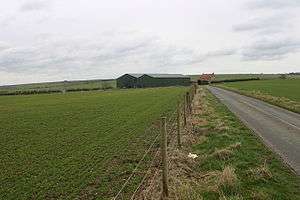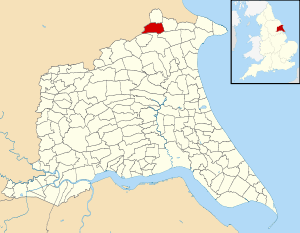Thwing and Octon
Thwing and Octon (also known as Thwing) is a civil parish in the northern Yorkshire Wolds in the East Riding of Yorkshire, England.
| Thwing and Octon | |
|---|---|
| Civil parish | |
 Typical parish landscape view | |
 | |
| Population | 203 (2011 census)[1] |
| OS grid reference | TA045701 |
| Civil parish |
|
| Unitary authority | |
| Ceremonial county | |
| Region | |
| Country | England |
| Sovereign state | United Kingdom |
| Post town | DRIFFIELD |
| Postcode district | YO25 |
| Dialling code | 01262 |
| Police | Humberside |
| Fire | Humberside |
| Ambulance | Yorkshire |
| UK Parliament | |
Description
Thwing and Octon is about 8 miles (13 km) north of the town of Driffield, and a similar distance west of Bridlington on the Yorkshire coast. It rises from about 45 m (148 ft) in the north-east corner of the parish to a high point of 163 metres (535 ft) in the south-west.[2] The parish covers an area of 1,628.644 hectares (4,024.47 acres).[3]
The civil parish is sparsely populated, with, according to the 2011 UK census, a population of 203,[1] the same as the 2001 UK census figure.[4] The main settlements are the village of Thwing and the smaller hamlet of Octon. There are farmsteads at Octon Grange, The Wold Cottage, and Willy Howe farm. Land use is almost entirely agricultural, predominately enclosed fields.[2] There is a private crematorium, East Riding Crematorium, at Octon Crossroads, built in 1997.[5][6]
Between 1894 and 1974 it was a part of the Bridlington Rural District, in the East Riding of Yorkshire.[7] Between 1974 and 1996 it was part of the Borough of North Wolds (later Borough of East Yorkshire), in the county of Humberside.
History and archaeology
There is evidence of significant human activity in the area beginning in at least the Neolithic Era: at Paddock Hill 0.6 miles (1 km) north of Octon, evidence of a henge dating from the late Neolithic has been discovered from crop marks and by excavation. The same site also shows evidence of re-use and modification into a hill fort during the Bronze Age, including artefacts typical of the Urnfield culture, and evidence of bronze metalworking. The site was re-used during the Anglo-Saxon period and contained houses including a grubenhaus and large rectangular hall; there was a cemetery with at least 130 inhumations east of the Bronze Age earthwork. During the 1200s a post mill was constructed.[8][9][m 1]
Two tumuli have been recorded and excavated in the northern part of the parish: the large mound named 'Willy Howe';[10][m 2] and another barrow, about 0.5 mi (0.8 km) to its west, in fields south of the village of Wold Newton.[11][m 3][note 1]
There are several other structures identified as barrows in the parish.[14] Other evidence of pre-historic settlement and activity include polished stone axes[15] and flint implements including arrowheads, chisels and knives,[16] as well as flint cores, tranchet axes and microliths;[17] pebble maceheads;[18] and bronze or Iron Age pottery.[19] A late Bronze Age (c. 1150 to 750 BC) penannular ring of pale and yellow gold applied on a base metal core was found by metal detection in 2004 near Thwing.[20]
Finds of Roman pottery, including Samian ware, provide evidence of occupation during the Roman era,[21] and a potential Romano-British settlement has been located about 0.6 miles (1 km) north-east of Thwing, with nearby rectilinear enclosures and trackways dating from the Iron Age or Roman period.[22]
A monastic grange associated with Meaux Abbey was recorded at Octon Grange, north of Octon, in the 12th century.[23][24]
The Wold Cottage meteorite fell in the parish in 1795, and is commemorated by a monument.[25]
In 1812 the parish's population was recorded as 268 persons in 37 houses; the predominant occupation was farming.[26] According to Sheahan, in the 1850s the parish had a total population of 599, and an area of 4,060 acres (1,640 ha),[27] the population had risen by a factor of two in the first half of the 19th century.[28] It fell during the last decades of the 19th century and the first half of the 20th century: by 1951 it was below the 1811 population level.[29] By the 1961 census the population had been reduced to 244.[30]
Notes
- quote: "About half a mile east from it is a very large barrow called Willy Howe, which was partly opened by the late Lord Londesborough [...] while about 300yds. to the north is another barrow, much above the ordinary size, though still not to be compared in that respect with Willy Howe."[11] The description of the location given matches a tumulus shown on the 1:10560 and 1:2500 scale Ordnance Survey maps up to 1950, afterwards labelled as site of, or absent. The barrow to the north appears to be that opened by John Robert Mortimer (barrow 284, TA 0484 7261) in 1894,[12] which was recorded by Mortimer to have been excavated by Lord Londesborough in 1857, and by Greenwell in 1887.[13]
References
- UK Census (2011). "Local Area Report – Thwing Parish (1170211276)". Nomis. Office for National Statistics. Retrieved 26 February 2018.
- Ordnance Survey. 1:25000. 2009
- "2001 Census Area Profile" (PDF). East Riding of Yorkshire Council. 2004. Archived (PDF) from the original on 18 March 2012. Retrieved 8 February 2013.
- UK Census (2001). "Local Area Report – Thwing Parish (00FB147)". Nomis. Office for National Statistics. Retrieved 7 April 2019.
- "Burial and cremation". East Riding of Yorkshire Council. Retrieved 25 August 2012.
- Historic England. "East Riding crematorium (1522651)". PastScape. Retrieved 27 November 2012.
- "Bridlington RD". A Vision of Britain Through Time. University of Portsmouth. Archived from the original on 10 February 2012. Retrieved 11 April 2013.
- "16th March – Recent work in the Bronze Age of East Yorkshire (Terry Manby)" (PDF). ERAS News. East Riding Archaeological Society (15): 8–9. August 1983.
- Sources:
- Historic England. "Paddock Hill (79885)". PastScape. Retrieved 12 January 2013.
- Historic England. "Paddock Hill (1203012)". PastScape. Retrieved 12 January 2013.
- See Willy Howe for details and sources.
- Greenwell, William (1877). "Parish of Thwing". British Barrows, a record of the examinations of sepulchral mounds in various parts of England. Clarendon Press. pp. 225–228. OL 20598245M.
- Historic England. "Wold Newton 284 (79863)". PastScape. Retrieved 12 January 2013.
- Mortimer, John Robert (1905). "Barrows not grouped &c. : Barrow No. 284 – Wold Newton". Forty Years' Researches in British and Saxon Burial Mounds of East Yorkshire ... A. Brown and Sons. OL 20467307M.
- Sources:
- Historic England. "Square barrows (910823)". PastScape. Retrieved 12 January 2013.
- Historic England. "Square barrows and pits (910824)". PastScape. Retrieved 12 January 2013.
- Historic England. "Six round and four square barrows (910760)". PastScape. Retrieved 12 January 2013.
- Historic England. "Square barrows (91072)". PastScape. Retrieved 12 January 2013.
- Historic England. "Possible square barrows (1372949)". PastScape. Retrieved 12 January 2013.
- Historic England. "Possible round barrows (1321676)". PastScape. Retrieved 12 January 2013.
- Historic England. "Possible round barrows (1307691)". PastScape. Retrieved 12 January 2013.
- Sources:
- Historic England. "Monument No. 910794". PastScape. Retrieved 12 January 2013.
- Historic England. "Monument No. 910801". PastScape. Retrieved 12 January 2013.
- Historic England. "Monument No. 910822". PastScape. Retrieved 12 January 2013.
- Historic England. "Monument No. 910761". PastScape. Retrieved 12 January 2013.
- Historic England. "Monument No. 910682". PastScape. Retrieved 12 January 2013.
- Historic England. "Monument No. 910800". PastScape. Retrieved 12 January 2013.
- Sources:
- "Penannular ring". The Art Fund – Art Saved. 2004. Retrieved 20 August 2006.
- "Ring found on farm declared treasure". Hull Daily Mail. 30 January 2004. Retrieved 7 February 2013.
- Source:
- Historic England. "Monument No. 79866". PastScape. Retrieved 12 January 2013.
- Historic England. "Monument No. 910684". PastScape. Retrieved 12 January 2013.
- Sources:
- Historic England. "Monument No. 79860". PastScape. Retrieved 12 January 2013.
- Historic England. "Monument No. 1171917". PastScape. Retrieved 12 January 2013.
- Historic England. "Monument No. 1307680". PastScape. Retrieved 12 January 2013.
- Historic England. "Octon Grange (910772)". PastScape. Retrieved 12 January 2013.
- Burton, Janet (2006) [1999]. The Monastic Order in Yorkshire, 1069–1215. Cambridge University Press. Consolidation of granges, p.258. ISBN 9780521034463.
- Historic England. "Commemorative monument recording fall of a meteorite, erected 1799 (79897)". PastScape. Retrieved 25 November 2019.
- Strickland, Henry Eustasius (1812). A general view of the agriculture of the East-Riding of Yorkshire. Board of Agriculture?. p. 319.
- Sheahan, James Joseph; Whellan, T. (1857). "Thwing". History and topography of the City of York, the East Riding of Yorkshire, and a portion of the West Riding: embracing a general review of the early history of Great Britain, and a general history and description of the county of York. 2. pp. 490–1.
- "1851 Census: Population tables : Thwing CP/AP". A Vision of Britain through time. columns 8–13. Retrieved 7 February 2013.
- Sources:
- "1891 Census: Population tables: Thwing CP/AP". A Vision of Britain through time. columns 8,9. Retrieved 7 February 2013.
- "1901 Census: County Report : Thwing CP/AP". A Vision of Britain through time. columns 9,10. Retrieved 7 February 2013.
- "1911 Census: Population tables: Thwing CP/AP". A Vision of Britain through time. columns 4,5. Retrieved 7 February 2013.
- "1921 Census: County Report: Thwing CP/AP". A Vision of Britain through time. columns 2,3. Retrieved 7 February 2013.
- "1931 Census: County Report: Thwing CP/AP". A Vision of Britain through time. columns 2,3. Retrieved 7 February 2013.
- "1951 Census: County Report: Thwing CP/AP". A Vision of Britain through time. column 2,3. Retrieved 7 February 2013.
- "1961 Census: County Report: Thwing CP/AP". A Vision of Britain through time. column 2,3. Retrieved 7 February 2013.
Map locations
- 54.122072°N 0.424974°W, Paddock Hill
- 54.136067°N 0.376626°W, Willy Howe
- 54.133643°N 0.392793°W, probable location of barrow excavated by Greenwell (see Note above).
Sources
- Gazetteer — A–Z of Towns Villages and Hamlets. East Riding of Yorkshire Council. 2006. pp. 9, 11.
External links
![]()